Famous Blue Paintings – Take a Look at the Best Blue Artworks
Blue is a color that is usually associated with calmness and nature, such as the blue of the ocean. However, blue artwork can also signify sadness or depression. Throughout history, paintings in blue have been created to impart a certain feeling or tone. Let us discover the different ways that painters have utilized the color blue in art throughout the years by checking out a few famous blue paintings.
Contents
- 1 Our Favorite Famous Blue Paintings
- 1.1 Elsie in a Blue Chair (1880) by Mary Cassatt
- 1.2 The Starry Night (1889) by Vincent van Gogh
- 1.3 Woman with Mango (1892) by Paul Gauguin
- 1.4 Saint Tropez, Storm (1895) by Paul Signac
- 1.5 The Old Guitarist (1903) by Pablo Picasso
- 1.6 Waterloo Bridge, Sunlight Effect (1903) by Claude Monet
- 1.7 The Conversation (1912) by Henri Matisse
- 1.8 Blue Painting (1924) by Wassily Kandinsky
- 1.9 Abstraction of Blue (1927) by Georgia O’Keeffe
- 1.10 No. 61 (Rust and Blue) (1953) by Mark Rothko
- 2 Frequently Asked Questions
Our Favorite Famous Blue Paintings
Humans have such a strong affinity for blue that the deeper the color becomes, the more powerfully it calls man to the eternal. This is because it is regarded as the color of the heavens, nobility, and power. Unlike red, which is hot, passionate, and dramatic, blue is light and airy, soothing, and grand. Considering the rich and long history of blue in art, we can see why it still has an intrinsic allure for observers.
The hue has captivated designers and artists all over the world, from its use in ancient cultures to modern-day blue artworks. Let’s take a look at some of the best paintings in blue ever created.
Elsie in a Blue Chair (1880) by Mary Cassatt
| Artist | Mary Cassatt (1853 – 1926) |
| Date Completed | 1880 |
| Medium | Pastel, paper |
| Location | Private Collection |
Mary Cassatt is a well-known artist from the Impressionist era, which stretched from the late 19th through to the early 20th centuries. Her works include a variety of social settings as well as beautiful portraits of various people. This 1880 artwork includes a variety of blue colors, ranging from striking, royal blues to livelier colors that reflect the brightness of the sun on the young girl.
The blue tones in the girl’s white dress, as well as her vivid blue eyes, combine to make this among the most famous blue paintings ever created.
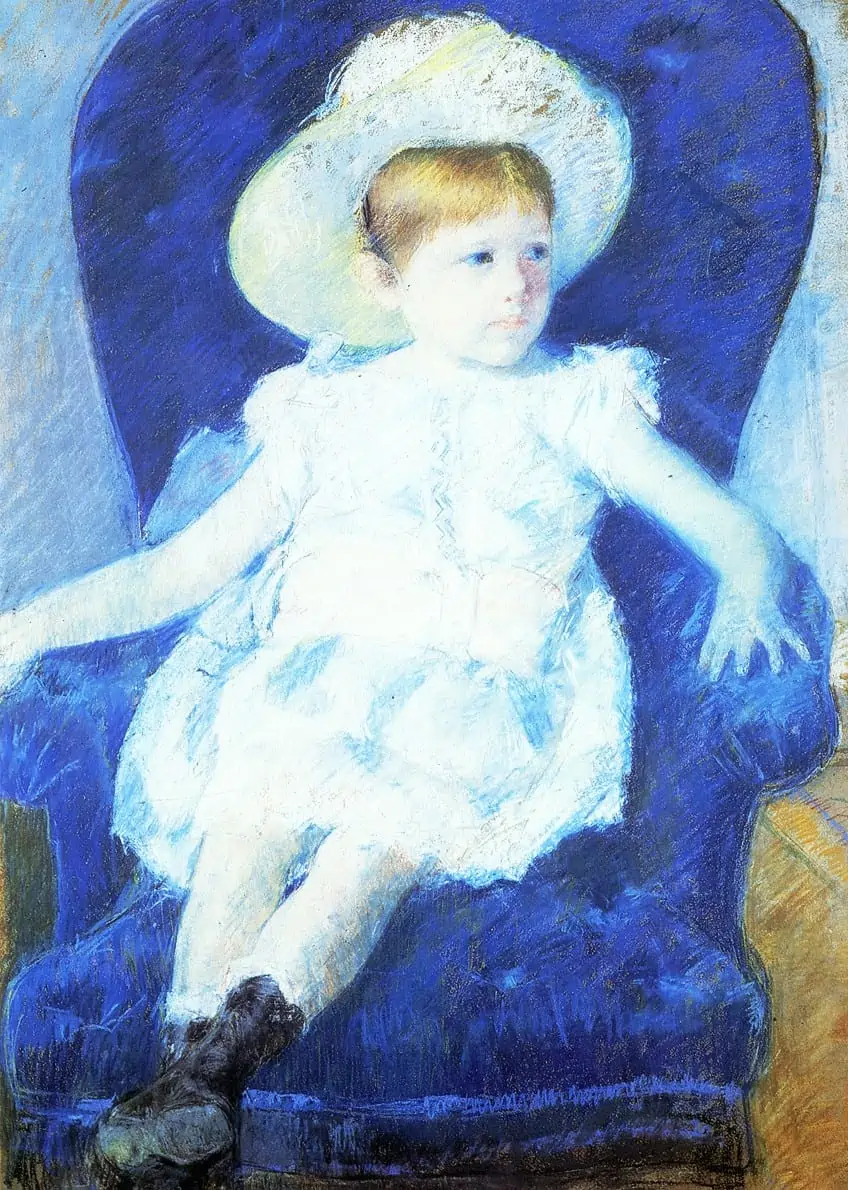
The Starry Night (1889) by Vincent van Gogh
| Artist | Vincent van Gogh (1853 – 1890) |
| Date Completed | 1889 |
| Medium | Oil on canvas |
| Location | Museum of Modern Art, New York City, United States |
Some of his most famous paintings have an explicit sense or feature that was reflective of his mental state, which is thought to have been afflicted by manic depression. Several of his works utilize his unique perception of coloration. Van Gogh famously painted the view from his insane asylum window, using swirling brushstrokes to simulate breezes in the night sky combined with shining stars.
The predominant blue tones in this 1889 piece suggest a vibrantly colored, calm nighttime scene.
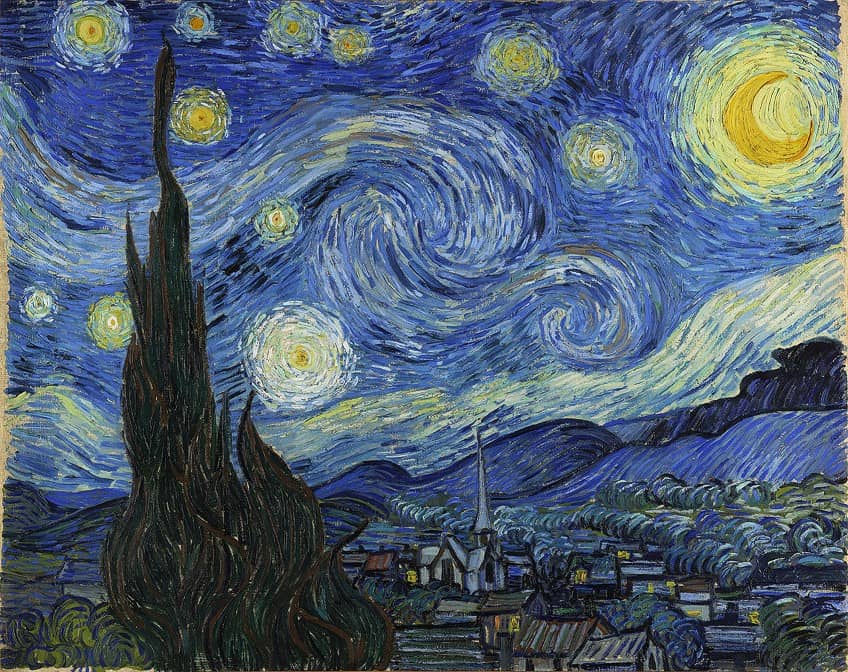
Woman with Mango (1892) by Paul Gauguin
| Artist | Paul Gauguin (1848 – 1903) |
| Date Completed | 1893 |
| Medium | Oil on canvas |
| Location | Baltimore Museum of Art, Maryland, United States |
Paul Gauguin led an extraordinary life and was not recognized as a well-known artist until after his passing in 1903. Throughout his career, he depicted many artworks in which he used dark, heavy tones to create a sense of vigor and vitality in a number of his subjects.
This 1892 artwork depicts a young woman whom the painter is said to have engaged when she was only 13 years old.

At first glimpse, the artwork appears to be nearly purple due to its deep blue coloration. This piece is one of many that Gauguin created while visiting the island of Tahiti. This piece features a brilliant use of blue coloration to depict the girl’s dress as it flows in different directions.
Saint Tropez, Storm (1895) by Paul Signac
| Artist | Paul Signac (1863 – 1935) |
| Date Completed | 1895 |
| Medium | Oil on canvas |
| Location | Musée d’Orsay, Paris, France |
Paul Signac was known as an artist who primarily used the art form of stippling, which consists of a sequence of systematical, intentional dots that make up the different subjects and figures in a work. The artist’s work is seen as an evident departure from the pervasive brushstrokes and an artist’s focus on detail.
Signac is mainly remembered for this particular work.
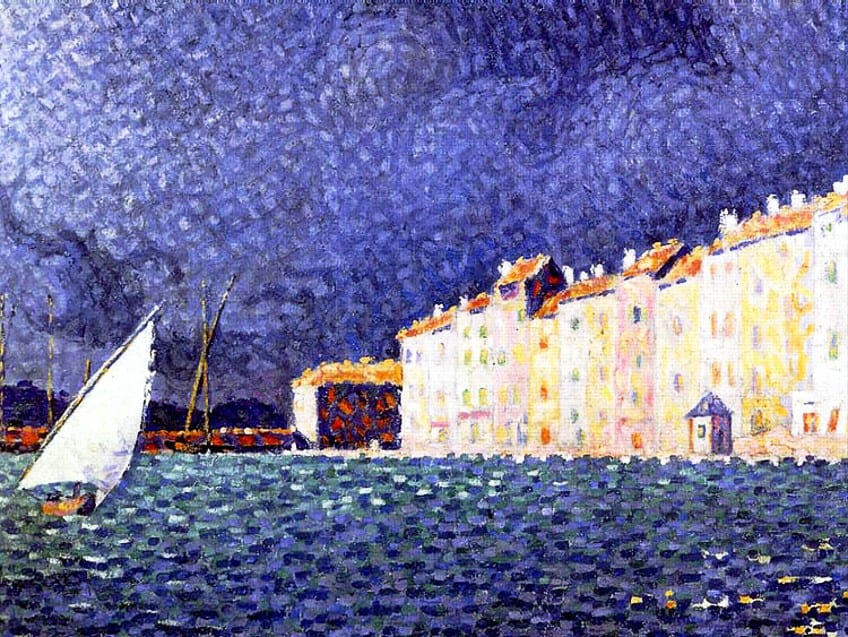
This painting was completed in 1895, at the peak of the era when creatives were experimenting with stippling. Signac has beautifully depicted an impending storm that is set to make hit land on a coastal city, with the strong wind suggested by the boat being pushed along the shore.
The blue tones in this painting range from the bright coloring of the ocean to the gloomy, heavy shades of blue of the sky filled with clouds.
The Old Guitarist (1903) by Pablo Picasso
| Artist | Pablo Picasso (1881 – 1973) |
| Date Completed | 1903 |
| Medium | Oil on panel |
| Location | Art Institute of Chicago, Chicago, United States |
The color blue is also associated with sadness and gloom, in addition to being seen as a color that conveys calmness and a sense of relaxation. This was true of Pablo Picasso’s well-known painting. Pablo Picasso created this piece not long after his close friend Casagemas took his own life following a protracted battle with mental illnesses and depression. The artist focused on those who were frequently oppressed and burdened by the woes that so frequently consume humankind in this piece and other works produced during this time.
The painting conveys a very strong sense of misery to the viewer due to the deep blue color used throughout.
Waterloo Bridge, Sunlight Effect (1903) by Claude Monet
| Artist | Claude Monet (1840 – 1926) |
| Date Completed | 1903 |
| Medium | Oil on canvas |
| Location | McMaster Museum of Art, Ontario, Canada |
Claude Monet produced a series of these blue artworks from his room at the Savoy Hotel, but he continued to work on them in his Giverny studio. While the paintings in blue appear to be impulsive and fresh, Monet did not execute them in a single sitting.
He was most likely working on many works of art at the same time, trying to portray nature’s fleeting instances of color.
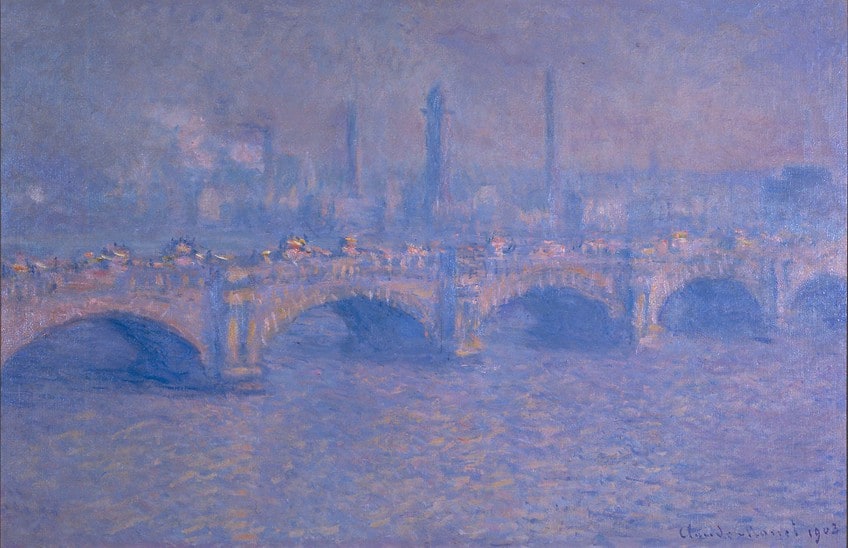
The series is primarily concerned with light and color. The constant subject allows for more precise observations of light, color, and weather relationships. The light shines through the foggy canopy in this blue artwork. There’s a sense of tension in the gray atmosphere, with intervals of light, as well as a few dark accents.
The Conversation (1912) by Henri Matisse
| Artist | Henri Matisse (1869 – 1954) |
| Date Completed | 1912 |
| Medium | Oil on canvas |
| Location | State Hermitage Museum, Saint Petersburg, Russia |
The blue hues in this painting are exceptional, dominating this endearing piece that depicts a discussion between two characters, probably a man and his wife. The man with a beard on the left is dressed in pajamas with light blue and white stripes.
He stands overlapping the bottom and top parts of the canvas and thus providing a frame to the canvas’ left side. His partner is seated, dressed in a black garment with dark hair hanging backward.
Because facial detail is restricted in this room, we must analyze more to determine the atmosphere. They appear to be looking at each other with serious gazes, even though the garden in the back is bright and cheerful. In many of his works of art, Matisse preferred to flatten perspective, which he does in this particular instance with the foreground of the blue-dominant area.
The blue tones may remind some of David Hockney’s later works.
Blue Painting (1924) by Wassily Kandinsky
| Artist | Wassily Kandinsky (1866 – 1944) |
| Date Completed | 1924 |
| Medium | Oil on canvas |
| Location | Solomon R. Guggenheim Museum, New York City, United States |
Wassily Kandinsky is one of the most well-known Abstract artists of all time. Many of his most well-known works incorporate a wide variety of linear forms, shapes, and colors, all of which combine to create a completely remarkable perception of artistic expression.
Kandinsky’s artwork is one of the most well-known blue paintings because of the artist’s extensive use of color across the entire canvas.
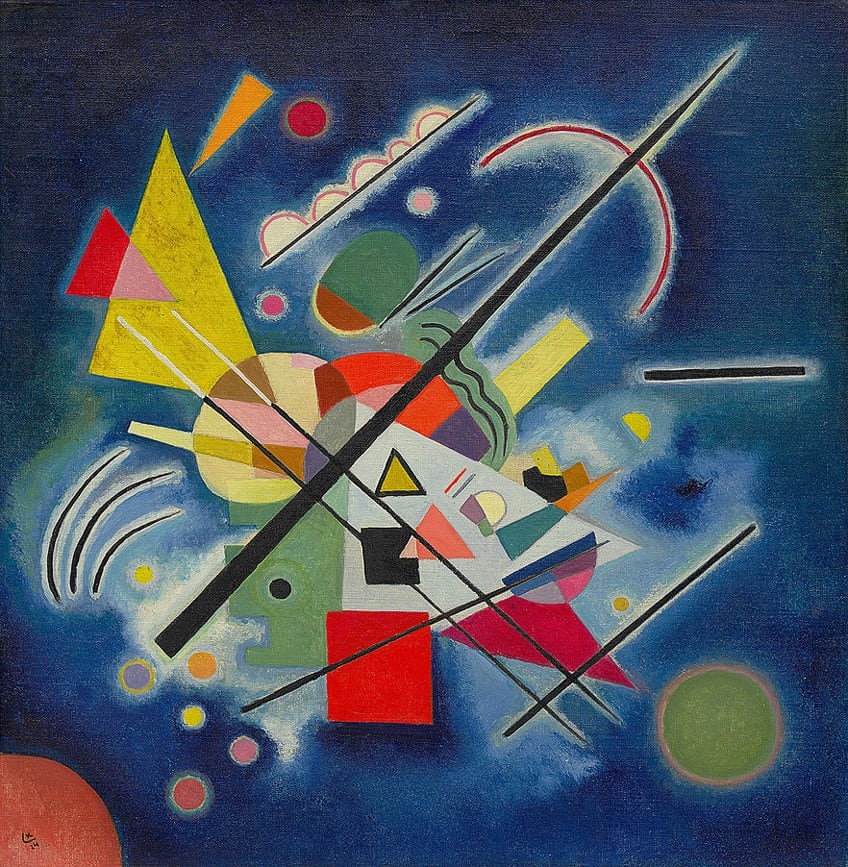
The edges are a very dark, deeper blue that gradually brightens toward the middle. This draws the viewer’s attention to the center of the painting by emphasizing the inner part. The artist created a few artworks focusing on the color blue, such as the Blue Rider (1903), which represented a cloaked rider on top of a horse.
For Wassily Kandinsky, the color blue represented spirituality.
Abstraction of Blue (1927) by Georgia O’Keeffe
| Artist | Georgia O’Keeffe (1887 – 1986) |
| Date Completed | 1927 |
| Medium | Oil on canvas |
| Location | Museum of Modern Art, New York City, United States |
Georgia O’Keeffe painted many brightly colored paintings during her lifetime, and this blue artwork is representative of her works. Shades of vivid and pastel color, drastic ice blues, and warmer turquoise stand out against a white background. The work appears to be a watercolor, typically painted against a pale background. However, it is executed entirely with oil on canvas.
The delicate colors are obtained by very thinly blending the oil paint and applying the hues across the canvas with broad brushstrokes.
The symbolism in this artwork is supported by two narratives. The entire canvas is taken up by a flower-like form that is palest in the middle and deepens toward the corners so that it seems to approach the audience as substantially as any real budding flower.
Although life forms are approximately symmetrical, a pale division that runs roughly down the middle of the piece serves as a reminder to the viewer that even the most perfect organisms have imperfections on either side.
No. 61 (Rust and Blue) (1953) by Mark Rothko
| Artist | Mark Rothko (1903 – 1970) |
| Date Completed | 1953 |
| Medium | Oil on canvas |
| Location | Museum of Contemporary Art, Los Angeles, United States |
Layered color is used effectively by Mark Rothko to enhance the hues in the blue painting and give it a quality that the painter describes as “inner light.” Rothko’s color gained a new luminosity when applied in thin washes (often made up of both egg and oil-based media).
The artist’s technique would seem simple at first glance, but upon closer inspection, it is abundantly diverse in its variety of effects.
Paint can be seen flowing upward across the surface in some places as he frequently flipped a painting while busy with it, sometimes modifying the final orientation late in the process. Like Mark Rothko’s other artworks from this time, it features large expanses of color delineated by irregular, blurry shades.
And with that, we have reached the end of our look at the most famous blue paintings ever to be created. Paintings in blue have always had a prominent place in art history, whether due to the calming effect of the color or its ability to make one feel sad or gloomy. Whichever way you look at it, using blue in art is effective at eliciting an emotional response from the audience.
Take a look at our blue paintings webstory here!
Frequently Asked Questions
Why Do Artists Create Paintings in Blue?
Blue is a very prominent color in nature, everything from the sky to the oceans is blue. Therefore, it is only natural that there would be so much blue in art. It is a diverse color that can be utilized in many ways, from soft baby blues to dark navy blues.
What Does the Color Blue Represent?
The color blue can represent many things, depending on the context in which it is used. For some people, it is a relaxing color that makes them think of the ocean and undulating waves. For other people, it is a sad color that can make them feel lonely or cold.
Jordan Anthony is a Cape Town-based film photographer, curator, and arts writer. She holds a Bachelor of Art in Fine Arts from the University of the Witwatersrand, Johannesburg, where she explored themes like healing, identity, dreams, and intuitive creation in her Contemporary art practice. Jordan has collaborated with various local art institutions, including the KZNSA Gallery in Durban, the Turbine Art Fair, and the Wits Art Museum. Her photography focuses on abstract color manipulations, portraiture, candid shots, and urban landscapes. She’s intrigued by philosophy, memory, and esotericism, drawing inspiration from Surrealism, Fluxus, and ancient civilizations, as well as childhood influences and found objects. Jordan is working for artfilemagazine since 2022 and writes blog posts about art history and photography.
Learn more about Jordan Anthony and about us.
Cite this Article
Jordan, Anthony, “Famous Blue Paintings – Take a Look at the Best Blue Artworks.” artfilemagazine – Your Online Art Source. November 8, 2022. URL: https://artfilemagazine.com/famous-blue-paintings/
Anthony, J. (2022, 8 November). Famous Blue Paintings – Take a Look at the Best Blue Artworks. artfilemagazine – Your Online Art Source. https://artfilemagazine.com/famous-blue-paintings/
Anthony, Jordan. “Famous Blue Paintings – Take a Look at the Best Blue Artworks.” artfilemagazine – Your Online Art Source, November 8, 2022. https://artfilemagazine.com/famous-blue-paintings/.



